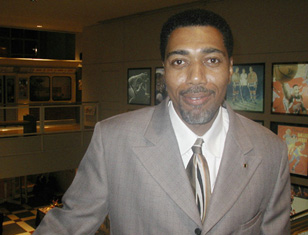Michael Evans

Michael Evans (Photo: Jennifer Linzer)
Two-thirds of their lives behind bars for a crime they did not commit
Michael Evans and Paul Terrywere 17 in 1976 when 9-year-old Lisa Cabassa was raped and murdered near her home on the south side of Chicago. They were convicted of the crime by a jury and languished behind bars for 27 years before DNA exonerated them in what the U.S. Court of Appeals labeled "a tragedy of epic proportions."
The convictions rested principally on the erroneous and apparently perjured testimony of Judith Januszewski, a 32-year-old secretary at a real estate office near the crime scene, who claimed to have seen two black youths, whom she eventually identified as Evans and Terry, with the Caucasian victim the evening she disappeared.
Januszewski did not come forward until four days after the crime — and even then, rather than going to the police, she contacted a man who had offered a reward in the case. Her credibility was all the more dubious because time records at the real estate office where she was employed indicated that she was at work at the time she initially claimed to have seen the men with the little girl. In view of the time records, police records were altered to make it appear that the abduction occurred later than the members of the Cabassa family said it occurred.
Police and prosecutors also claimed that Evans confessed, although he denied it. The alleged confession was not a jury issue — the trial judge granted a defense motion to suppress — but it no doubt was a factor in the charging decision.
The crime
The victim and her brother, Ricky, 11, left their home at 8628 S. Saginaw Avenue in Chicago early the evening of January 14, 1976, to walk to the home of a friend a few blocks away. Lisa, however, turned back, complaining of a headache, while Ricky continued to the friend's home. When Ricky returned home alone about 8:25 p.m., the family realized that Lisa was missing. After searching the neighborhood, the children's mother, Carmen Cabassa, called police at about 9 p.m. She placed the time that Lisa and Ricky had left home at 6:30 p.m.
Lisa's body was found shortly before 3 a.m. the next day in an alley about two miles away. She had been sexually assaulted and strangled. Cook County Medical Examiner Robert Stein theorized that Lisa must have struggled greatly due to the pain she was experiencing, and that therefore one assailant could not have both subdued her and sexually assaulted her. The DNA evidence, 27 years later, gives no indication that more than one assailant was involved.
Januszewski emerges
On January 19, four days after the child's body was discovered Januszewski, whose office was on East 87th Street near Saginaw Avenue, called a man who had advertised a $5,000 reward in the case. That man, Frank Martin, called police. Later that day, according to police reports, Januszewski told detectives that at "approximately 6:37 p.m." on January 14, on the corner of 86th and Saginaw, she had seen two black youths struggling with a young white girl.
From descriptions provided by Januszewski, police prepared composite sketches of two young black men. Curiously, however, Januszewski did not identify the girl with whom the youths were struggling, even though she had known Lisa Cabassa for more than a year.
Five weeks later, on February 24, Januszewski contacted police, saying she wanted "to clear the air." She now reported that she had received veiled threats from a youth she knew as Earl Jones. She said she had seen Jones standing nearby as the two youths she previously had mentioned struggled with the little girl, whom she now identified as Lisa Cabassa.
Januszewski also said, for the first time, that she also knew one of the youths involved in the struggle — Michael Evans. Police arrested Evans the next day and he was indicted for rape, kidnapping, and murder.
In the following days, police repeatedly interviewed Januszewski. At some point, they showed her a 1974 Bowen High School yearbook, asking her to look through it in case it contained photos of either of the other individuals involved in the struggle. Although Paul Terry's photo was in the yearbook, she failed to identify it. She did claim, however, that one student pictured resembled the young man she knew as Earl Jones. That student was questioned but released after Januszewski failed to identify him in a lineup.
How Terry was implicated
Terry did not become a suspect until Keith Jones, a 16-year-old friend of Evans, was questioned by police several months later. Jones, in a statement he would soon disavow as a coerced fabrication, implicated Evans and a man named James Davis in the crime. In addition, Jones said that one of the composite sketches prepared from the descriptions Januszewski had provided in January looked somewhat like another neighborhood youth — Paul Terry.
In November 1976, Januszewski identified Terry in a lineup as the second youth she had seen struggling with Lisa Cabassa. At some point, she also identified James Davis in a lineup as the man she previously had known as Earl Jones. Based solely on the lineup identifications, the Cook County State's Attorney's Office obtained indictments charging Terry and Davis with rape, kidnapping, and murder.
Time of the crime shifts
Meanwhile, Evans waived a jury and went to trial before Cook County Circuit Court Judge Earl E. Strayhorn. By now, the prosecution had disclosed Januszewski's work timecard, which showed that she had been at work until 8 p.m. the day of the Cabassa abduction — a fact that could not be reconciled with Carmen Cabassa's statement that her daughter had left home around 6:30 p.m.
The problem was addressed simply by changing the time; 27 years later, the victim's parents acknowledged in interviews with Chicago Tribune reporters Maurice Possley and Steve Mills that the family's original account of the timing "was changed to fit Januszewski's account.
Despite apparent misgivings about Januszewski's credibility, Strayhorn found Evans guilty. Before sentencing, however, the prosecution disclosed that Januszewski had received money from the State's Attorney's Office — ostensibly for relocation. Because that information had not been provided to the defense prior to trial, Strayhorn vacated the conviction on prosecutorial misconduct grounds, and Evans's case was consolidated for retrial with the cases of Terry and Davis.
Joint trial
Before the trial, prosecutors dropped the charges against Davis because Keith Jones recanted. Evans and Terry, neither of whom had a criminal past, went on trial before a jury and Cook County Circuit Court Judge Frank W. Barbaro in April 1977.
Defense lawyers pressed the time issue on cross examination of Januszewski, who responded by denying that she had ever stated to anyone that the abduction occurred at 6:37 p.m. She said a Chicago police detective "made that up out of his own head."
Some jurors evidently doubted Januszewski. After six hours of deliberation over two days, with the intervening night in sequestration, the jury sent a note to the judge, Frank W. Barbaro, saying, "We are deadlocked unalterably. What shall we do?"
Barbaro responded, "It is your duty to continue to deliberate." After further deliberation, the jury sent a second note saying, "In almost four additional hours of deliberations we cannot reach a unanimous decision." The defense moved for a mistrial, but Barbaro denied the motion and responded to the jury, "Continue to deliberate." A little more than an hour later, the jury found Evans and Terry guilty on all counts.
Barbaro sentenced each to concurrent terms of 200 to 400 years for murder, 75 to 150 years for aggravated kidnapping, 75 to 150 years for rape, and 50 to 100 years for deviate sexual assault.
Convictions affirmed
In December 1979, the First District Illinois Appellate Court affirmed the convictions and sentences, holding that "Januszewski's testimony, if believed, was not so improbable, doubtful, or vague as to raise a reasonable doubt as to defendants' guilt." The unanimous decision, written by Judge Robert Downing, would have ended the case, and Evans and Terry would have spent the rest of their lives in prison, except for a confluence of serendipitous circumstances.
Serendipity
The lead prosecutor in the case had been Thomas M. Breen, who after leaving the State's Attorney's Office had become a prominent member of the Chicago defense bar. Breen represented Gary Dotson, who in 1989 became the first prisoner in Illinois, to be exonerated by DNA, and Rolando Cruz, who in 1995 was exonerated, in part by DNA.
In 1994, while working on the Cruz case with Northwestern University Law Professor Lawrence C. Marshall, Breen confided that he had begun to have doubts about the prosecution of Evans and Terry. When the Center on Wrongful Convictions was established in 1999, Marshall asked Karen Daniel, Center staff counsel, to look into the possibility of obtaining DNA testing of seminal evidence in the case.
"Unindicted co-ejaculator theory"
Under an Illinois statute that Marshall had been instrumental in drafting and passing the previous year, DNA testing was mandated in cases in which the result would have "the scientific potential to produce new, noncumulative evidence materially relevant" to claims of actual innocence. However, the State's Attorney's Office opposed the testing under the guise of what defense attorneys have come to call "the unindicted co-ejaculator theory" — that even if DNA testing excludes convicted defendants as sources of biological material, it is possible that the material came from an unknown additional party to the crime. In this case, the State noted that a third man, James Davis, had been implicated in the crime by Januszewski.
In 2001, however, Center on Wrongful Convictions Daniel and Jeffrey Urdangen, a private practitioner representing Terry, persuaded the Circuit Court to order the testing. The results, obtained in September 2002, excluded Evans, Terry, and James Davis as sources of seminal evidence recovered in the case.
Prosecutors responded by seeking additional testing, ostensibly on the chance of identifying an unindicted co-ejaculator. The procedures dragged the case out, keeping Evans and Terry in custody, until the State's Attorney's Office grudgingly agreed on May 23, 2003, that Evans and Terry were entitled at least to a new trial, even though one was highly unlikely given the evidence. Prosecutors then left Evans and Terry in limbo for three more months before finally dropping the charges on August 22.
After informing Judge Porter that the State's Attorney's Office was dropping its opposition to a new trial, Assistant State's Attorney Mark Ertler argued that a substantial cash bond should be set, vowing that the prosecution would retry Evans and Terry, despite the fact that they have no specific theory as to how the offenses occurred, no physical evidence linking Evans or Terry to the crime, and no idea as to the identity of the man who left his semen in Lisa's body. Judge Porter, however, ordered their release on their own recognizance. Two hours later, after the Cook County Sheriff's Office processed the required paperwork, Evans and Terry walked out of his courtroom — free for the first time in more than 27 years.
Civil actions
Evans and Terry filed federal civil rights suits against the Chicago Police Department and various officers for violations of his civil rights. After a 2006 trial, a federal jury denied Evans's claim, evidently finding insufficient evidence that his wrongful conviction was the result of deliberate police misconduct, as opposed to simple negligence. Police are immune from liability as long as they acted in good faith, albeit negligently. In light of the jury's action, Terry settled his claim in 2009 for $2.7 million.
— Rob Warden

